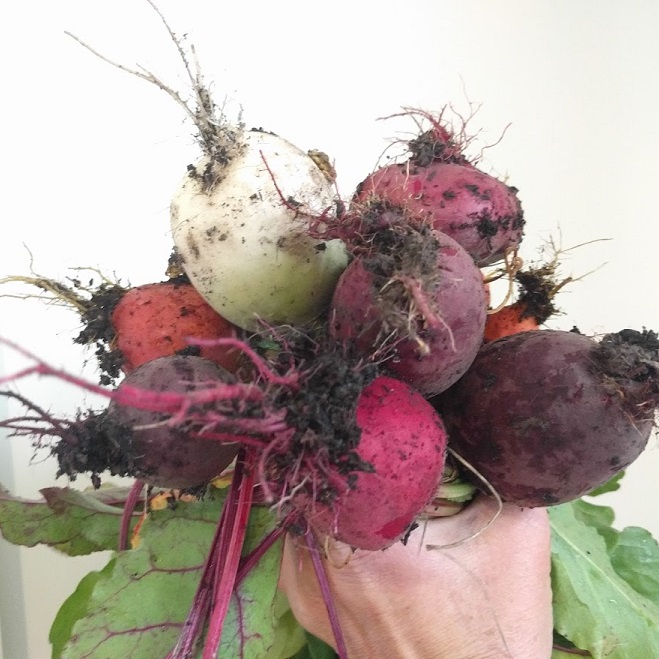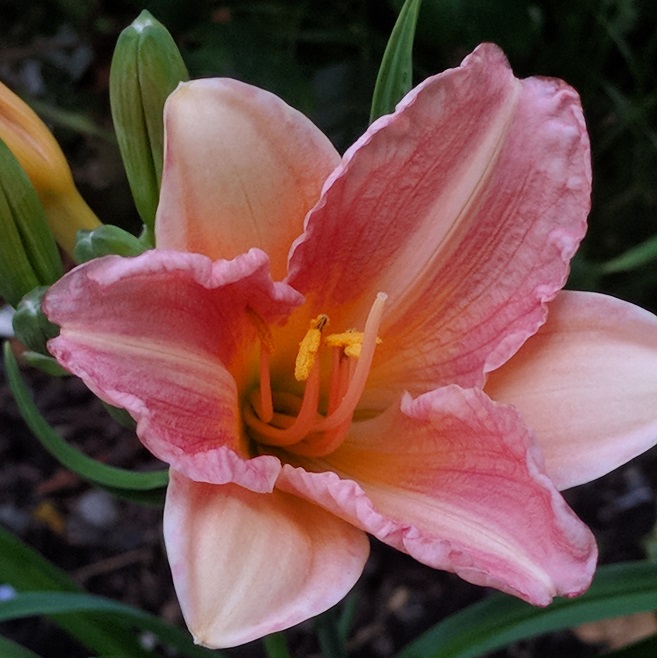Minette Tonoli offers some tips for household and community food resilience
This article was first published by Soil & Health Association’s OrganicNZ magazine in May-June 2020
The reason I believe the human race will survive in almost any near apocalyptic situation is threefold:
1. We have insatiable hope, even when things seem utterly hopeless;
2. We have the ability to laugh; jokes and funny memes soon follow after worrisome events, and
3. A growing number are turning to gardening for food, medicine, emotional support, psychological healing, and for the good of the earth.



Panic Buying
These beliefs were tested, and resoundingly passed muster during the outbreak of the Covid19 pandemic in March this year [2020]. Faced with isolation restrictions, the scarcity that panic buying created on supermarket foodstuffs, and an unsure future, one of the most positive outcomes was the exponential rise in people showing interest in gardening – creating food in their own back gardens or even small space balcony pots and windowsills for their families, friends and neighbours.
Vegetable and herb seedlings started selling out in some big box stores early in March, and seed sales spiked too. There was a massive influx of members to vegetable growing and self-sufficiency Facebook groups – noobs eager to learn from seasoned gardeners and preppers on what the best things are to grow in such uncertain times and what to do with them.
Gardening for self-reliance and morale
Growing food during trying periods is not new. Victory Gardens – vegetable, fruit, and herb gardens planted in backyards and public parks – were encouraged during World War I and World War II as a way to supplement rations, but also to boost morale of the public. Similarly, subsistence gardens during the Great Depression in the 1930s not only met the people’s immediate need for food, but also encouraged a sense of community, lifted spirits, and stimulated the economy.
When an economic downturn is likely, and households and communities face becoming more self-reliant, food and resources need to be relocalised. Here are some ideas on how to get growing and stowing with an at-home survival food plan.


Homegrown survival food plan
When first setting out to grow fresh vegetables, think about crops for which you have space and resources (including water), that grows well in your climate, and that your family actually eats. Crops that mature in a relatively short period of time will ensure food is available soon, and engender a positive sense of achievement.
WINTER GROWING FAST MATURING VEGETABLES (sow late summer through autumn)
30 - 40 Days
- Amaranth: green and red
- Cress
- Mizuna and Mibuna
- Pak Choi
- Radish
- Rocket
- Spinach - Baby Leaf
40-50 Days
- Broccoli Raab
- Kale - Scotch Blue
- Miner's Lettuce
- Minutina
- NZ Spinach
- Tat-soi
50-60 Days
- Beetroot
- Cabbage - green and red express
- Corn Salad
- Endive
- Kale- Scarlet, Blue Ridge, Ursa
- Kohlrabi
- Komatsuna
- Lettuce & Mesclun
- Pea - Snow & Sugar Snap
- Silverbeet
60-70 Days
- Broad Beans
- Carrots
- Cavolo Nero
- Onion - Purplette, Pearl Drop
- Pea - Shelling
- Turnip




Thinking beyond the immediate or medium term, perennial vegetables such as asparagus globe artichoke, horseradish and watercress, as well as a few berry bushes and fruit trees, provide bang for buck for many years, and is a good idea to future-proof food supply from the garden.


Make the most of what you have
· Saving seeds from your garden is a valuable skill and safeguards against relying on strained outside sources for your food plant supply during difficult times.
· Don’t throw away vege scraps from food prep – keep freezing all the bits like carrot tops, celery leaves, broccoli stems and leftover herbs until you have a large pot that you can boil up to make a vegetable stock.
· Learn about eating the ‘unusual’ bits of crops that are normally discarded, i.e., did you know you can eat beetroot leaves like spinach, and the outer leaves of cauliflower, broccoli, and kohlrabi can be used like collard greens.

Growing Food in Small Spaces
Even when space is a premium, food can still be grown – balcony gardening, or potted food culture has a large following in modern small-space living. Being creative with margins such as verges, or unused spaces such as vertical walls can further increase the available growing area. Herbs do especially well in containers.



Sprouts and Microgreens
Soaking and sprouting seeds wakes up dormant nutrients and make the food far more digestible. Simply soak nuts or seeds for a few hours and then rinse daily with fresh water until they germinate. Eat sprouts – seed and all – fresh in salads and sandwiches or add to stir fries and soups. They make a nutrient-dense topping and can be blended into smoothies.
Microgreens go a bit further than sprouting – growing a one-off mass of mini plants which are harvested by snipping the stem and leaves just above the growing medium. Best used fresh, these add colour, taste, nutrition and interest to almost any type of dish.
Sprouting Guide: (from: *wholefully.com/sprouting-101)
Seed, Legume, or Grain
- Alfalfa
- Broccoli
- Chickpeas
- Clover
- Mung Beans
- Millet
Seed Quantity
- 3 Tbsp
- 3 Tbsp
- 1 Cup
- 3 Tbsp
- 1/3 Cup
- 1 Cup
Yield (cups)
- Alfalfa
- Broccoli
- Chickpeas
- Clover
- Mung Beans
- Millet
Harvest (days)
- Alfalfa
- Broccoli
- Chickpeas
- Clover
- Mung Beans
- Millet
Microgreen Guide
Seed
- Amaranth
- Beet - Rainbow Blend
- Cress
- Kale - Cavolo Nero
- Orach
- Radish
- Pea - Tasty Tendrils
- Watercress
Rate of Sowing per tray (grams)
- 3
- 25
- 7
- 8
- 10
- 50
- 200
- 2
Days to Maturity
- 30
- 28
- 14
- 8
- 8
- 8
- 7
- 28

Wild and foraged food and Edible ornamentals
The exciting world of foraging is another off-grid food source that cannot be overlooked when thinking survival. New Zealand not only offers great free-for-the-taking seafood, including edible seaweeds, but also interesting bush food, and some public parks and recreational areas often have fruit trees from which one may harvest freely.
Nutrient-dense weeds can even be collected – often from our own lawns. There are a great number of wild and unruly plants that we bemoan in our orderly gardens that make prime fare, including dandelion, plantain, stinging nettle, chickweed, oxeye daisy, and cleavers.
It’s worthwhile knowing that there are ornamental garden plants that are edible as well, including Dahlia flowers and tubers, hosta leaves, daylilies flowers and canna lilies.



DISCLAIMER: Please be sensible when eating weeds, foraged foods, and ornamental garden plants. Do NOT eat a plant without absolute positive identification, and being very sure that it is indeed edible.
Swap and share
Food sharing and produce swaps have long-standing value in rural communities and within self-sufficiency groups. Social platforms such as Neighbourly and Facebook make it easy to connect with people within a small geographic area. Real-world initiatives such as community fruit and vege stands and community gardens further enable these ideals, as do libraries and garden clubs, which often have free access seed banks.
Squirrel it away
While gardening, swapping and foraging will ensure you have food when you need it, so prolific is nature that you may end up with far more than you can use immediately. Being prepared to stow away excess will further ensure you always have enough to eat.
• Freezing: most vegetables can be blanched and frozen, lasting up to a year. Leafy greens such as spinach, silverbeet and kale are great candidates.
• Drying: culinary herbs are easy to dry, and late-season fruit can be made into dried fruit rings, or fruit rolls.
• Preserving: pantry pleasures abound when you get into preserving: think bottled beetroot, pickled carrots, delectable fruit jams, and spicy chutneys.
• Fermenting: ferments like sauerkraut and kimchi are a wonderful way to preserve and have the added benefit of being full of good probiotics.







2 Comments
Thank you
A great pleasure! Happy growing 🙂